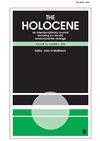Living through changing climates: Temperature and seasonality correlate with population fluctuations among Holocene hunter-fisher-gatherers on the west coast of Norway
IF 1.8
3区 地球科学
Q3 GEOGRAPHY, PHYSICAL
引用次数: 0
Abstract
The use of archaeological proxy records representative of population dynamics is paramount for a richer understanding of prehistoric cultural change, but its use require a dialectic assessment between proximate climatic drivers and ultimate cultural responses. Focusing on the Stone Age archaeological record of Western Norway (11,500–4300 cal. BP), this paper presents an exhaustive empirical curation and statistical testing between changing climates and demographic responses among coastal hunter-fisher-gatherers. The results connect long-term demographic fluctuations with changes in annual mean temperatures and seasonality and the results are discussed in relation changes in technology, subsistence and mobility. The paper also highlights the process of population decline and cultural loss towards the end of the Late Mesolithic (ca. 7000–6000 cal. BP) and emerging cultural novelties and population re-growth during the Early and Middle Neolithic (ca. 6000–4300 cal. BP). However, despite its strong correlation, the archaeological record of Western Norway lacks sufficient detail to ascribe an exclusive explanatory role to climate change, especially in episodes of significant population decline. This helps to emphasise that changing climates, while evidently central, form but a part of a larger system of interactions leading to demographic fluctuations and cultural change, the substantiation of which requires significant empirical improvements to the archaeological record.生活在变化的气候中:温度和季节与挪威西海岸全新世狩猎-捕鱼-采集者的人口波动有关
使用代表人口动态的考古代理记录对于更深入地了解史前文化变化至关重要,但其使用需要在直接的气候驱动因素和最终的文化反应之间进行辩证评估。关注挪威西部石器时代的考古记录(11500–4300 cal.BP),本文对沿海狩猎-捕鱼采集者的气候变化和人口反应进行了详尽的实证管理和统计测试。结果将长期人口波动与年平均气温和季节性的变化联系起来,并将结果与技术、生存和流动性的变化进行了讨论。该论文还强调了中石器时代晚期(约7000–6000 cal.BP)人口下降和文化损失的过程,以及新石器时代早期和中期(约6000–4300 cal.BP。然而,尽管有很强的相关性,但挪威西部的考古记录缺乏足够的细节,无法将气候变化作为唯一的解释作用,尤其是在人口大幅下降的情况下。这有助于强调,气候变化虽然显然是核心,但却是导致人口波动和文化变化的更大互动系统的一部分,要想证实这一点,就需要对考古记录进行重大的实证改进。
本文章由计算机程序翻译,如有差异,请以英文原文为准。
求助全文
约1分钟内获得全文
求助全文
来源期刊

Holocene
地学-地球科学综合
CiteScore
4.70
自引率
8.30%
发文量
106
审稿时长
4 months
期刊介绍:
The Holocene is a high impact, peer-reviewed journal dedicated to fundamental scientific research at the interface between the long Quaternary record and the natural and human-induced environmental processes operating at the Earth''s surface today. The Holocene emphasizes environmental change over the last ca 11 700 years.
 求助内容:
求助内容: 应助结果提醒方式:
应助结果提醒方式:


